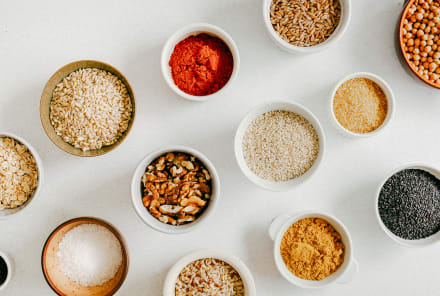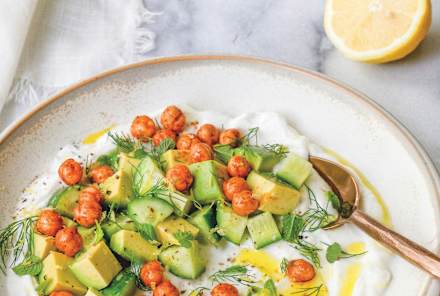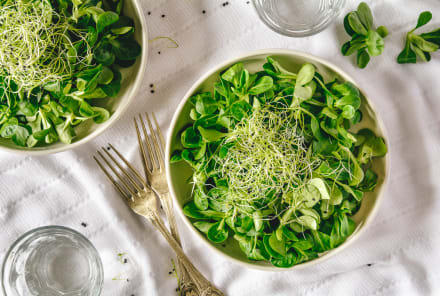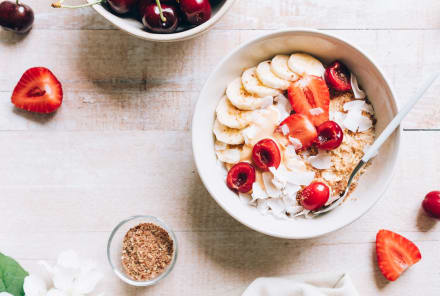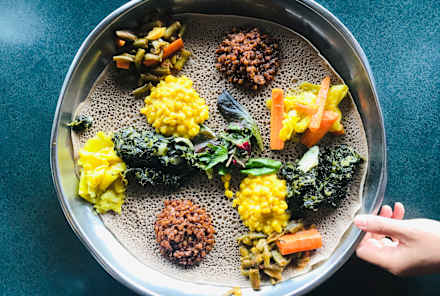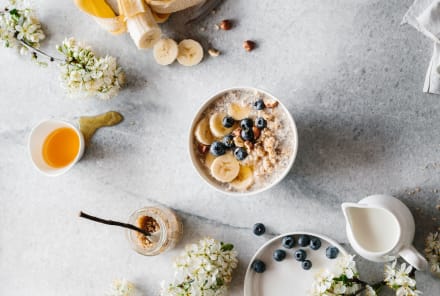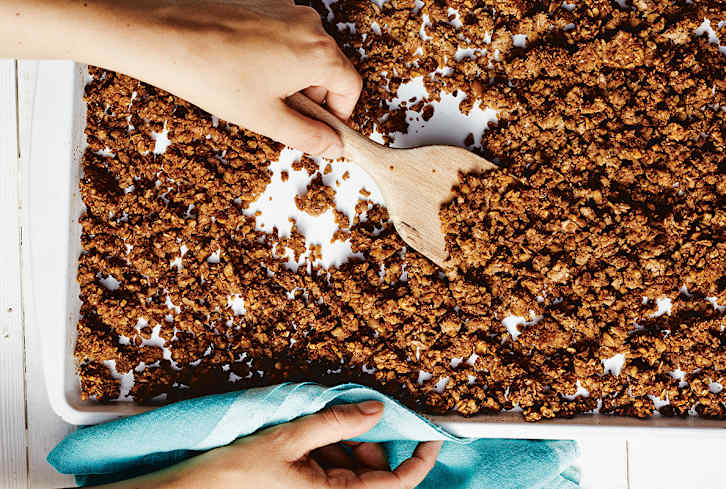Advertisement
Dairy Is Back On Table — We Just Seem To Be Eating (Not Drinking) It


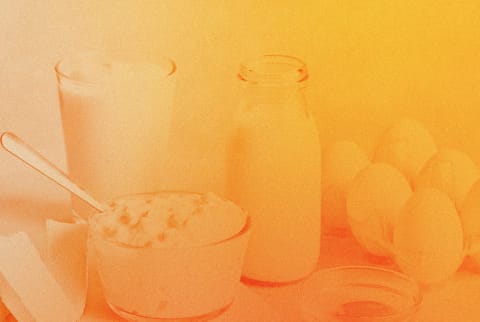
I’ve always pledged my loyalty to dairy (maybe it’s the midwesterner in me). It’s creamy, delicious, and packed with nutrients. But peer pressure is hard to ignore. As people started to turn away from dairy in favor of plant-based alternatives in the name of sustainability, animal rights, or perceived health benefits, I've also dabbled in almond, oat, and soy milk. Now, societal preference is coming full circle, and many people are welcoming dairy back into their lives.
Dairy has sneakily become the it ingredient this year, from butter boards to cottage cheese hacks, and feta eggs. We’re expecting the food group to solidify its comeback in the well-being world in 2024, just not in 1990s Got milk? campaign way.
We predict that more people will be choosing to eat—rather than drink—their dairy in the year ahead, with a focus on sustainably sourced, probiotic, and high-fat options.
Meet the experts
Jason H. Karp
Jason H. Karp is the founder & CEO of HumanCo, a mission-driven company that builds brands committed to making products better in every dimension including Snow Days, Against the Grain, Cosmic Bliss, and True Food Kitchen.
Barbara Ruhs, M.S., R.D.
Barbara Ruhs, M.S., R.D. is a food marketing nutrition expert. Previously a dietitian for Harvard University, she is now the owner of MarketRD—a marketing agency that provides nutrition and health strategies to food brands.
Jesse Merril
Jesse Merrill is the co-founder and CEO of the dairy company Good Culture. He started the company after he saw the power of food as a medicine following an ulcerative colitis diagnosis.
What’s drawing people back to dairy?
The lure of dairy products' simple ingredients, health benefits, and favorable taste are some of the main reasons more people are coming back to it.
Simplicity
“As conscious consumers become more educated and skeptical, they are realizing they want real, whole foods that come from nature,” says Jason H. Karp, co-founder and CEO of HumanCo, a company that builds brands focused on healthier, more sustainable living.
And dairy products fit the bill with ingredient lists that are often quite short. They may contain just milk, cream, vitamins (from fortification), salt, and possibly probiotic cultures. Plant-based dairy alternatives, on the other hand, can rack up lengthy ingredient lists that include gums and seed oils.
Nutritional composition
As mindbodygreen predicted in last year's Wellness Trends, there's now a growing awareness of how important protein is for muscle gain, fat loss, and overall metabolic health. And dairy products are a good source of it: Greek yogurt provides around 17 grams 1for every ¾ cup, while cottage cheese offers around 19 grams2 of protein per ¾ cup. If your daily protein needs come in around 100 grams, one serving of these foods satisfies up to 19% of them.
While dairy has always been applauded for its complete protein profile (especially in comparison to protein-lacking plant alternatives), its fat content has garnered some controversy.
Full-fat dairy products were vilified starting in the 1970s because of reported concerns about their saturated fat content3. (For reference, an 8-ounce cup of whole milk contains 4.5 grams of saturated fat and a glass of skim milk contains 0.1 grams).
“Every dietitian has been taught that full-fat dairy and saturated fat increase the risk of heart disease. However, emerging science may refute this scientific foundation,” emphasizes nutrition and retail food expert Barbara Ruhs, M.S., R.D.
For example, a systematic review and meta-analysis published in May 2023 in the journal Advances in Nutrition found that high dairy consumption (three or more servings a day) of any fat percentage did not have any detrimental effects on measures of cardiometabolic health4. In fact, all dairy seemed to improve blood pressure, and yogurt specifically improved waist circumference, triglycerides, and HDL (aka the good) cholesterol. An older study from 2016 reviewed data from over 15,000 adults (ages 35-74) and found that total dairy consumption—especially full-fat dairy—was linked to a decreased risk of metabolic concerns5.
Taste
People are now remembering (and embracing) just how good dairy tastes—especially cheese. According to the North America Dairy Market Report, cheese is the largest category of dairy foods now offered in the United States.
While many people were quick to switch to dairy milk alternatives and either adapt to (or prefer) the taste, vegan cheeses don’t offer the same mouthfeel or ability to melt.
Where is dairy headed next: The rise of sustainable, full-fat, probiotic-rich options
“The consumer has become much more educated on the narratives that all plant-based foods are superior for both human and planetary health—and the corollary false narrative that all animal products have a negative impact,” asserts Karp.
At the same time, consumer concern about the environmental impact of animal agriculture is driving the industry to implement more sustainable practices, says Ruhs.
Take Alexandre Family Farm, the first certified regenerative dairy farm in the United States, which operates in a way that improves (not depletes or even maintains) soil health. Organic Valley is another dairy company leading the way with innovative sustainability initiatives. They're working with 500 farmer-members to implement more than 1,2000 climate-conscious practices (like tree planting and composting) over the next five years.
"Regenerative and organic foods will keep growing and this is a huge victory for people’s health, for farmers, and for the health of our soils," says Karp.
Farm insights
But that's not all. “Sustainability is also driving innovation for animal-free dairy products,” says Ruhs. The company Perfect Day, for example, uses precision fermentation to create dairy. Precision fermentation skips the cows and goes right to producing milk proteins from microorganisms.
According to a Perfect Day life-cycle assessment (a way to assess the overall environmental impact of a product), fermentation reduces greenhouse gas emissions by up to 97%, water consumption by up to 99%, and energy use by up to 60% compared to traditional dairy farming.
For those who do want to bypass the cow, Perfect Day animal-free dairy protein is now commercially available through companies like Nestle, Mars, and Bored Cow, and you can find it in products from ice cream to cream cheese.
We'll soon have more probiotic-rich dairy choices
Dairy foods, particularly yogurt and kefir, are some of the most recognizable dietary sources of probiotics—live microorganisms like bacteria that offer benefits for gut health, immunity, and more6. Probiotic cultures are typically added to dairy either before or after fermentation. Fermented dairy is often linked to more favorable7 (not just neutral) health benefits than non-fermented dairy and is well-tolerated by those with lactose intolerance8.
And while yogurt definitely isn’t going anywhere, it’s no longer your sole option when it comes to probiotics.
Good Culture is one standout brand offering probiotic-rich foods, including cottage cheese, cream cheese, sour cream, and milk. Cottage cheese had a major comeback in 2023 thanks to the wave of attention on social media (it now has over 1.2 billion views on TikTok) as people realize it’s a great source of protein. And Good Culture cottage cheese captured the largest sales growth, with about a 72% increase from last year.
“Cottage cheese was historically thought of as a diet food, but we have helped reimagine the category with nutrient-dense cottage cheese products that support overall wellness, and deliver a thick, creamy, crave-able taste experience,” says Jesse Merrill, co-founder and CEO of Good Culture.
Full-fat is back, too. According to a new report from CoBank, part of the US Farm Credit System, butterfat (the name of fat found in milk or cream) will continue to boom in the year ahead. From 2011 to 2022, butterfat products grew by 27%. But again, liquid milk isn’t the only thing driving this increase.
My experience
Dairy and plant-based alternatives can (and should) coexist
While more and more people will add high-quality dairy back to their plates in the year ahead, plant-based alternatives aren’t going anywhere.
“Lactose intolerance is widespread [65% of people globally 10are actually intolerant] and plant-based alternatives take lactose out of the equation altogether,” says Ruhs. “Also, plant-based milk offers a new range of flavors and taste profiles that are attracting customers to the category.” They’re also the best option for folks with a milk allergy.
Karp projects that consumer demand for less processed, simpler foods sourced with integrity will continue to grow. This, in turn, may lead to more favorably formulated plant-based products.
After all, plant-based products don’t have to include a laundry list of additives. Cosmic Bliss, one of Karp’s HumanCo brands, for example, offers both grass-fed dairy ice cream and coconut milk ice cream with an astonishingly simple ingredient list—coconut milk, coconut syrup, coconut cream, and plant extracts.
Overall, we expect diversity among both dairy and plant-based alternatives to grow and people to hop back and forth between products. We may opt for oat milk in our coffee in the morning, and yogurt for a high-protein snack in the afternoon.
Forecasting the future
People are finding their way back to simplistic, wholesome dairy products—and for good reason. After all, dairy adds creaminess, protein, and a sense of nostalgia to food that’s difficult to replicate. But the dairy we’re reaching for today isn't the fat-free, sugar-laden, artificially sweetened dairy of a not-so-distant past. It's produced sustainably, full of beneficial fats, and chock-full of live probiotic cultures.
In 2024, we expect dining tables and lunch boxes to be more inclusive of a variety of dairy foods (yogurts, cheeses, and butters) that bring us closer to our daily protein goals. And we hope that interest in sustainable, organic farming practices will continue to generate industry-wide changes that benefit human and planetary health.
10 Sources
- https://fdc.nal.usda.gov/fdc-app.html#/food-details/170894/nutrients
- https://fdc.nal.usda.gov/fdc-app.html#/food-details/172179/nutrients
- https://www.sciencedirect.com/science/article/pii/S2161831322004367
- https://pubmed.ncbi.nlm.nih.gov/36914032/
- https://www.sciencedirect.com/science/article/pii/S0022316622089738?via%3Dihub
- https://www.nature.com/articles/nrgastro.2014.66
- https://pubmed.ncbi.nlm.nih.gov/32277831/
- https://pubmed.ncbi.nlm.nih.gov/30351161/
- https://www.sciencedirect.com/science/article/abs/pii/S0031938423001774
- https://www.ncbi.nlm.nih.gov/books/NBK532285/

Why Nutrition Is Key To Changing Your Relationship With Alcohol
Brooke Scheller, DCN, CNS

Why Alcohol Sabotages Your Gut Health & How To Get Back On Track
Brooke Scheller, DCN, CNS

Why Nutrition Is Key To Changing Your Relationship With Alcohol
Brooke Scheller, DCN, CNS

Why Alcohol Sabotages Your Gut Health & How To Get Back On Track
Brooke Scheller, DCN, CNS

Why Nutrition Is Key To Changing Your Relationship With Alcohol
Brooke Scheller, DCN, CNS

Why Alcohol Sabotages Your Gut Health & How To Get Back On Track
Brooke Scheller, DCN, CNS

Why Nutrition Is Key To Changing Your Relationship With Alcohol
Brooke Scheller, DCN, CNS

Why Alcohol Sabotages Your Gut Health & How To Get Back On Track
Brooke Scheller, DCN, CNS
